In the same section
-
Share this page
Ion transport across lipid bilayers
Since 2015, the EMNS Lab also studies ion transport across lipid membranes using supramolecular carriers. In 2020, Hennie Valkenier presented the transport research at the CHAINS conference and her talk can be watched on You Tube and we have written several review articles:
- Anion Transporters Based on Halogen, Chalcogen, and Pnictogen Bonds: Towards Biological Applications.
A. Singh, A. Torres-Huerta, F. Meyer, H. Valkenier,* Chem. Sci. 2024, 15 (37), 15006–15022.
https://doi.org/10.1039/D4SC04644G. (review) - Synthetic transporters for oxoanions.
K. Norvaisa, A. Torres-Huerta, H. Valkenier,* Curr. Opin. Chem. Biol. 2024, 83, 102542.
https://doi.org/10.1016/j.cbpa.2024.102542 (review) - Transport of Bicarbonate by Anion Receptors
L. Martínez-Crespo,* H. Valkenier,* ChemPlusChem 2022, 87, e202200266.
https://doi.org/10.1002/cplu.202200266 (review)
#1 Chloride transport across lipid membranes by supramolecular receptors
Channel-forming membrane proteins are responsible for the transport of charged species through cell membranes. Dysfunction in ion transport is the cause of numerous diseases, of which cystic fibrosis is probably the most well-known. It is possible to compensate for the defect or under-expressed membrane protein channel activity by using synthetic molecules which can carry anions through the lipid bilayer. Our goal is to study the thermodynamics, kinetics, and structural parameters of anion carriers inside lipid bilayer membranes in order to highlight the key parameters governing the efficiency of organic receptors as transporters. We use both state-of-the-art physical organic chemistry and biophysical methods, such as advanced NMR techniques, microcalorimetry and fluorescence spectroscopy, to obtain an extensive understanding of the transport phenomenon and propose new rules for the design of the next generation of anion transporters.

Heads: Dr Hennie Valkenier & Prof. Kristin Bartik
Co-workers/researchers: Dr Matúš Chvojka, Dr Anurag Singh, Dr Karolis Norvaisa, Dr Glenn Grauwels
Collaborations: Prof. Ivan Jabin (ULB), Prof. Vladimir Sindelar (Masaryk University, Brno), Prof. Tony Davis (University of Bristol)
Funding: FNRS (Post-doctoral and PhD fellowships to HV, KN, MC and GG) and ERC
Publications:
Substituent effects of fluorinated bambusurils on their anion transport
Chvojka, M., Šindelář, V., & Valkenier, H., Organic & Biomolecular Chemistry (2025).
Anion Transport by Bambusuril-Bile Acid Conjugates: Drastic Effect of the Cholesterol Content
Torrisi, J., Chvojka, M., Jurček, P., Zhang, X., Zeng, H., Šindelář, V., & Valkenier, H., Angewandte Chemie International Edition 64(9), e202424754 (2025).
Cyanostilbenes as Selective Chloride Carriers Relying on CH-anion Interactions
A. Singh, L. Halgreen, P.R. Panda, A. Torres-Huerta, N. Tumanov, J. Wouters, H. Valkenier,* Chem. Eur. J. 31(54), e02050 (2025).
Tuning CH Hydrogen Bond-Based Receptors toward Picomolar Anion Affinity via the Inductive Effect of Distant Substituents
M. Chvojka, D. Madea, H. Valkenier,* V. Sindelar,* Ang. Chem. Int. Ed. 63, e202318261 (2024).
Calix[6]arenes with halogen bond donor groups as selective and efficient anion transporters
Singh A., Torres Huerta A., Vanderlinden T., Renier N., Martínez-Crespo L., Tumanov N., Wouters J., Bartik K., Jabin I. & Valkenier H., Chem. Commun. 58, 6255-6258 (2022). OA
Hydrazones in anion transporters: The detrimental effect of a second binding site
Martínez-Crespo L., Halgreen L., Soares M., Marques I., Félix V. and Valkenier H., Organic & Biomolecular Chemistry 9, 8324-8337 (2021).
Repositioning Chloride Transmembrane Transporters: Transport of Organic Ion Pairs
Grauwels G., Valkenier H., Davis A. P., Jabin I., & Bartik K., Angewandte Chemie International Ed. 58, 6921-6925 (2019).
Fluorinated Bambusurils as Highly Effective and Selective Transmembrane Cl−/HCO3− Antiporters
Valkenier H., Akrawi O., Jurček P., Sleziaková K., Lízal T., Bartik K. and Šindelář V., Chem 5(2), 429-444 (2019) - Download post-print.
#2 Synthetic transporters for oxoanions
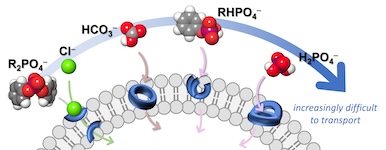
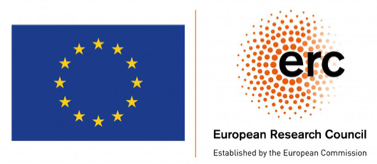
Current co-workers/researchers: Dr Karolis Norvaisa, Ms Priyanka Rani Panda, Dr Aaron Torres Huerta
Former researchers: Dr Alessio Cataldo, Dr Lau Halgreen, Dr Anurag Singh, Dr Matúš Chvojka, Dr Anca Dascalu, Dr Luis Martinez Crespo

Publications:
Structural requirements of synthetic anionophores for inorganic phosphate and phosphate esters
A. Torres-Huerta, K. Norvaisa, A. Cataldo, P.-O. Tits, P. R. Panda, C. M. Dias, A. P. Davis, S. E. Bodman, S. J. Butler, H. Valkenier,* ChemistryEurope 3(2), e202400076 (2025).
Transmembrane Transport of Phosphate by a Strapped Calix[4]pyrrole
Cataldo A., Norvaisa K., Halgreen L., Bodman S. E., Bartik K., Butler S. J. & Valkenier H., JACS 145(30), 16310-16314 (2023).
A Semiflexible Tetrahydrazone Macrocycle for Binding of Pyrophosphate and Smaller Anions
L. Halgreen, A. Torres-Huerta, K. Norvaisa, G. De Leener, N. Tumanov, J. Wouters, K. Bartik, H. Valkenier,* J. Org. Chem. 89, 6853-6864 (2024).
The Role of the Organic Moiety in the Diffusion and Transport of Carboxylates into Liposomes
A. Torres-Huerta, H. Valkenier,* Molecules 29, 5124 (2024).
Dissecting Transmembrane Bicarbonate Transport by 1,8-Di(Thio)Amidocarbazoles
K. Maslowska-Jarzyna, A. Cataldo, A. Marszalik, I. Ignatikova, S. J. Butler, R. Stachowiak, M. J. Chmielewski,* H. Valkenier,* Org. Biomol. Chem. 20, 7658-7663 (2022).
Transmembrane Transport of Bicarbonate Unravelled
Martínez-Crespo L., Hewitt S.H., Alessandro de Simone N., Šindelář V., Davis A.P., Butler S. and Valkenier H., Chem. Eur. J. 27, 26, 7367-7375 (2021). Cover Picture
#3 Transmembrane transport of copper(I) cations by synthetic receptors
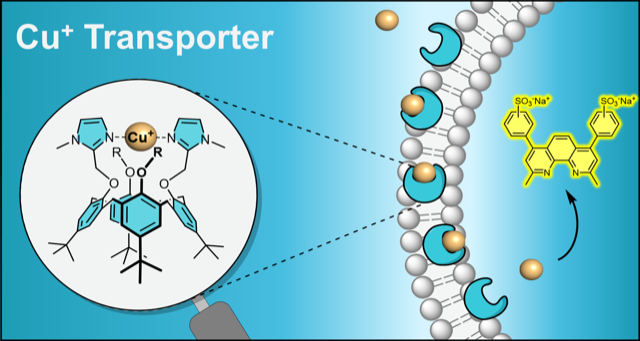
The aim of this project is to develop and study synthetic molecules which are able to selectively bind and transport copper(I) ions through lipid bilayer membranes. These molecules are integrated in the membrane and behave as mobile carriers by diffusing across the bilayer.
Head: Dr Hennie Valkenier
Co-worker/researcher: Mr Gianluca Weyckmans Mele, Mr Yannick Dussein, Dr Marcin Konopka, Dr Nathan Renier
Collaboration: Prof. Ivan Jabin (ULB, Laboratory of Organic Chemistry), Prof. Aurélien Deniaud (Université Grenoble Alpes), Dr Anna Maria Marini (ULB, Biology of Membrane Transport Lab)
Funding: Fonds de la Recherche Scientifique–FNRS (PDR and FRIA PhD fellowship) and Wallonie-Bruxelles International (WBI).
Publication:
Transmembrane transport of copper(I) by imidazole-functionalised calix[4]arenes
Renier N., Reinaud O., Jabin I. & Valkenier H., Chem. Commun. 56, 8206-8209 (2020). Download pre-print.
Based on the publication of Nathan's article in Chemical Communication, the RSC has published an interview with Hennie: https://blogs.rsc.org/cc/2020/12/09/chemcomm-milestones-hennie-valkenier/
#4 Development of methods to study ion transmembrane transport in vesicles
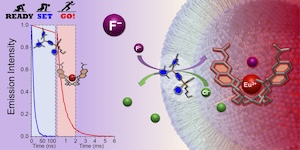
Head: Dr Hennie Valkenier
Co-workers/researchers: Ms Hasna Sherin Ummat, Dr Karolis Norvaisa, Dr Matúš Chvojka, Dr Alessio Cataldo, Dr Aaron Torres Huerta, Dr Luis Martinez Crespo
Collaborations: Prof. Stephen Butler (Loughborough University) and Prof. Benoit Scheid (ULB, TIPs lab)
Funding: European Research Council (ERC, grant agreement No 802727), Fonds de la Recherche Scientifique–FNRS (fellowships to HV, KN, MC, and AC), and ULB Actions de recherche concertées (ARC project GUV3).
Publications:
Transmembrane transport of fluoride studied by time-resolved emission spectroscopy
A. Cataldo, M. Chvojka, G. Park, V. Šindelář, F. P. Gabbaï, S. J. Butler,* H. Valkenier,* Chem. Commun. 59, 4185-4188 (2023).
The Lucigenin Assay: Measuring Anion Transport in Lipid Vesicles
M. Chvojka, A. Singh, A. Cataldo, A. Torres-Huerta, M. Konopka, V. Šindelář, H. Valkenier,* Analysis & Sensing 4, e202300044 (2023).
The Role of the Organic Moiety in the Diffusion and Transport of Carboxylates into Liposomes
A. Torres-Huerta, H. Valkenier,* Molecules 29, 5124 (2024).
Transmembrane Transport of Bicarbonate Unravelled
Martínez-Crespo L., Hewitt S.H., Alessandro de Simone N., Šindelář V., Davis A.P., Butler S. and Valkenier H., Chem. Eur. J. 27, 26, 7367-7375 (2021). Cover Picture
#5 Applications of dynamic covalent chemistry for ion transport
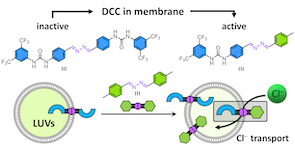
Head: Dr Hennie Valkenier
Co-workers/researchers: Dr Aaron Torres Huerta, Dr Marcin Konopka, Dr Lau Halgreen, Dr Anca Dascalu, Dr Luis Martinez Crespo
Funding: European Research Council (ERC, grant agreement No 802727), Fonds de la Recherche Scientifique–FNRS (HV), and Wallonie-Bruxelles International (WBI).
Publications:
Controlling the transmembrane transport of chloride by dynamic covalent chemistry with azines
M. Konopka, L. Halgreen, A.-E. Dascalu, M. Chvojka, H. Valkenier,* Chem. Sci. 16, 3509-3515 (2025).
Dynamic covalent chemistry with azines
Dascalu A-E., Halgreen L., Torres-Huerta A. & Valkenier H., Chem. Commun. 58, 11103-11106 (2022). OA
#6 Lipid-based Nanoreactors for the assembly of metal organic complexes in confined space

Head: Dr Hennie Valkenier
Co-workers/researchers: Dr Aaron Torres Huerta
Collaborations: Dr Miriam de J. Velásquez-Hernández (KU Leuven), Dr. Ondřej Jurček (Masaryk University, Brno)
Funding: European Union's Horizon Europe research and innovation programme under the Marie Skłodowska-Curie (Grant Agreement No. 101065037) and NFFA-Europe Pilot Transnational Access Activity (proposal ID520).
Publication:
Spatiotemporal Control of the Formation of Luminescent Lanthanide Complexes in Liposome-Based Nanoreactors
A. Torres-Huerta,* M. de J. Velásquez-Hernández, E. Tamarit-Amoros, M. Raschetti, D. Pinkas, O. Jurček, J. Pérez, H. Valkenier,* Ang. Chem. Int. Ed. , e0202510471 (2025). OA
